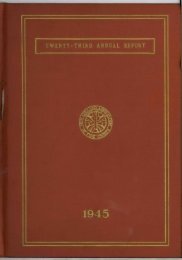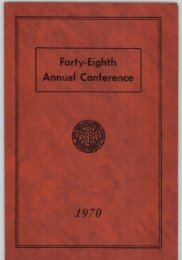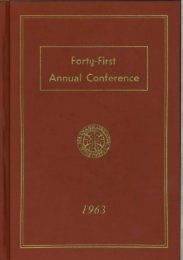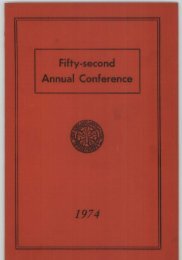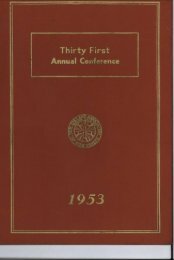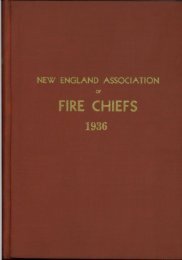NEAFC 32nd Annual Conference.pdf - New England Association of ...
NEAFC 32nd Annual Conference.pdf - New England Association of ...
NEAFC 32nd Annual Conference.pdf - New England Association of ...
Create successful ePaper yourself
Turn your PDF publications into a flip-book with our unique Google optimized e-Paper software.
NEw E~XIGLAI’CD .AssocI~TIOlXI OF FIRE CHIEFS<br />
You Fire Chie.fs have no problem more difficult than the protection, <strong>of</strong> the<br />
40,000 to 50,000 people_ who are passing their last, slow days. in the multitudinous<br />
nursing, convalescent, and boarding homes for the aged, and in the city<br />
and town infirmaries <strong>of</strong> <strong>New</strong> <strong>England</strong>. In the same buildings, lookirig after<br />
these patients,, there must be at least 7,500 more staff employees, who also<br />
look to you for protection.<br />
With reference to the institutions for the aged, just exactly how many<br />
<strong>of</strong> these places there are, and how many folks are in them, nobody quite knows.<br />
The figure I have just used <strong>of</strong> 40,000 to 50,000 is just a guess. In Massachusetts<br />
alone, at the last count, there were 735 licensed convalescent homes, and<br />
856 boarding homes, with an approximate total <strong>of</strong> 22,320 patients. One such<br />
boarding home houses 276 patients, asmany as the-entire population <strong>of</strong> some<br />
<strong>of</strong> our smaller <strong>New</strong> <strong>England</strong> towns. For the whole o£ <strong>New</strong> <strong>England</strong>, you can<br />
double these Massachusetts figures, as I did in my estimate <strong>of</strong> 40,000 to 50,000.<br />
But, aside from the licensed institutions, there are unlicensed bootleg<br />
homes, we hear, and beyond all these, there must be hundreds., probably thousands<br />
<strong>of</strong> smaller homes with only two to four patients, apiece, that are outside<br />
the purview <strong>of</strong> our licensing system altogether. So that you can add another<br />
20,000 to the 50,000 I mentioned before, if you want to include them all.<br />
However, the number <strong>of</strong> such institutions, and <strong>of</strong> their patients, grows<br />
steadily, month by month.<br />
Of the people who run these boarding and nursing homes, a subs[tantial<br />
proportion are <strong>of</strong> the highest type, such as doctors, experienced nurses., Competent<br />
middle-aged women with capital. ’Under such a management, the patients<br />
get adequate, sympathetic, loving care.<br />
Another type <strong>of</strong> management is in the business, purely for pr<strong>of</strong>it, but<br />
nevertheless may run high-grade institutions.<br />
A few <strong>of</strong> the owners, I am sorry to say, are completely unfit by character<br />
and disposition to care for elderly people, or anybody else, and their establishments<br />
are unfit, also.<br />
The respectable houses and the public <strong>of</strong>ficials concerned, want to see to<br />
it that these are cleaned up, or cleaned out. Not only the legislative commission<br />
on which I am now serving, and on which Chief Kimball has been serving,<br />
but you Fire Chiefs, are among the public <strong>of</strong>ficials for whom this. cleanup is<br />
a necessary duty.<br />
Now, let us look at the. patients. Not all <strong>of</strong> these folks are old, but<br />
most <strong>of</strong> them are, for their average age is 71. Some <strong>of</strong> them are spry, and in<br />
good health, and could get out <strong>of</strong> a burning building on their own. Many are<br />
senile; many are ill. Large numbers <strong>of</strong> them are bed-ridden and helpless. They<br />
cannot move, in case <strong>of</strong> fire; they must be moved. And, to quote Roy Beaudry,<br />
head o£ the Inspection Division <strong>of</strong> our Massachusetts Department <strong>of</strong> Public<br />
Safety, most <strong>of</strong> these patients "could not negotiate stairways or fire escapes,<br />
especially in the midst, <strong>of</strong> smoke, gas or flames."<br />
As to who pays for them, there is a certain proportion <strong>of</strong> these people<br />
who are in these places, voluntarily. In some instances, they or their families<br />
pay their way. Some have relatives who are thoughtful <strong>of</strong> them. Often, their<br />
relatives are merely anxious to get the folks out <strong>of</strong> the way.<br />
The bulk <strong>of</strong> them are placed in homes by public <strong>of</strong>ficials, and the general<br />
public pays for their keep. Most <strong>of</strong> these public <strong>of</strong>ficials are:.~umane,-if some-<br />
109 "



